

Rebecca Nurse Bio. Rebecca Nurse was the daughter of William Towne, of Yarmouth, Norfolk County, England where she was baptized Feb. 21, 1621.
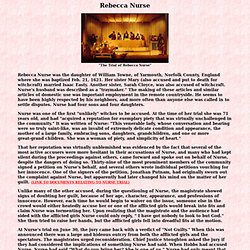
Her sister Mary (also accused and put to death for witchcraft) married Isaac Easty. Another sister, Sarah Cloyce, was also accused of witchcraft. Nurse's husband was described as a "traymaker. " The making of these articles and similar articles of domestic use was important employment in the remote countryside. He seems to have been highly respected by his neighbors, and more often than anyone else was called in to settle disputes. Nurse was one of the first "unlikely" witches to be accused. Petitions relating to the trial of Rebecca Nurse for witchcraft. (Petition for Rebecca Nurse) We whose nams Are hearunto subscribed being desired by goodman Nurse to declare what we knewe concerning his wives conversation for time past: we cane testfie to all whom it may concerne that we have knowne her for: many years and According to our observation her: Life and conversation was According to her profession and we never had Any: cause or grounds to suspect her of any such thing as she is now Acused of.
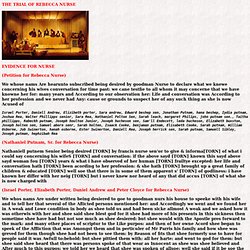
Rebecca Nurse. (Examination of Rebecca Nurse) Mr.

Harthorn. What do you say (speaking to one afflicted) have you seen this Woman hurt you? Martha Corey. The Salem Witch Trials, 1692 The seeds of the hysteria that afflicted Salem Village, Massachusetts were sown in January 1692 when a group of young girls began to display bizarre behavior.
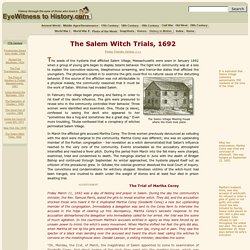
The tight-knit community was at a loss to explain the convulsive seizures, blasphemous screaming, and trance-like states that afflicted the youngsters. The physicians called in to examine the girls could find no natural cause of the disturbing behavior. If the source of the affliction was not attributable to a physical malady, the community reasoned that it must be the work of Satan. Witches had invaded Salem. In February the village began praying and fasting in order to rid itself of the devil's influence. In March the afflicted girls accused Martha Corey. Martha Corey. 21 March 1691/2 Mr Hathorne.
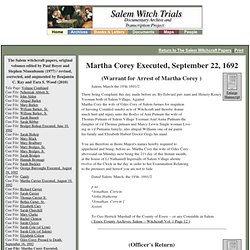
You are now in the hands of Authority tell me now why you hurt these persons Martha Kory. I do not. who doth? Pray give me leave to goe to prayer. Salem Witch Trials historical biographies for Bridget Bishop, George Burroughs, Martha Carrier, Giles Corey, Martha Corey, Ann Foster, Dorcas Good, Sarah Good, Rebecca Nurse, Samuel Parris, Elizabeth Proctor, John Proctor and Tituba. Tituba. Tituba Tituba was an Indian woman, not (as commonly believed) a Negro slave.
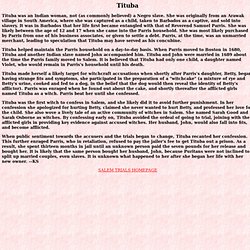
She was originally from an Arawak village in South America, where she was captured as a child, taken to Barbados as a captive, and sold into slavery. It was in Barbados that her life first became entangled with that of Reverend Samuel Parris. She was likely between the age of 12 and 17 when she came into the Parris household. She was most likely purchased by Parris from one of his business associates, or given to settle a debt. Tituba helped maintain the Parris household on a day-to-day basis. Tituba made herself a likely target for witchcraft accusations when shortly after Parris's daughter, Betty, began having strange fits and symptoms, she participated in the preparation of a "witchcake" (a mixture of rye and Betty's urine, cooked and fed to a dog, in the belief that the dog would then reveal the identity of Betty's afflictor).
Tituba. Tituba the Ind'n Woem'ns Examn March. 1. 1691/2 [March 1,1692] Why doe you hurt these poor Children?
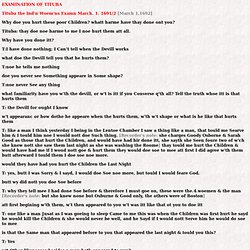
Whatt harme have thay done ont you? Tituba: thay doe noe harme to me I noe hurt them att all. Why have you done itt? T:I have done nothing; I Can‘t tell when the Devill works what doe the Devill tell you that he hurts them? T:noe he tells me nothing doe you never see Something appeare in Some shape? T:noe never See any thing what familiarity have you w'th the devill, or w't is itt if you Converse q'th all? T: the Devill for ought I know w't appearanc or how dothe he appeare when the hurts them, w'th w't shape or what is he like that hurts them T: like a man I think yesterday I being in the Lentoe Chamber I saw a thing like a man, that tould me Searve him & I tould him noe I would nott doe Such thing.
Would they have had you hurt the Children the Last Night. Parris Vs Tituba. Biography of Ann Putnam, Jr. Ann Putnam Jr.
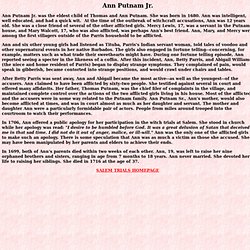
Ann Putnam Jr. was the eldest child of Thomas and Ann Putnam. She was born in 1680. Ann was intelligent, well educated, and had a quick wit. At the time of the outbreak of witchcraft accusations, Ann was 12 years old. She was a close friend of several of the other afflicted girls. Ann and six other young girls had listened as Tituba, Parris's Indian servant woman, told tales of voodoo and other supernatural events in her native Barbados. After Betty Parris was sent away, Ann and Abigail became the most active--as well as the youngest--of the accusers.
In 1706, Ann offered a public apology for her participation in the witch trials at Salem. Ann Putnam court records. Transcript: (Ann Putnam, Jr. v.

Ann Pudeator )Case: Ann Pudeator Executed, September 22, 1692(AnnPutnam, Jr. v. Ann Pudeator ) (Reverse) September the 7. 92 annPutnam afarmid ... to the grand Inquest that ann pudeatar: tould har that she flu by aman in the neight in to a hous Transcript: (Ann Putnam, Jr. v. Sarah Good. Sarah Good Sarah Good was the daughter of a prosperous Wenham innkeeper, John Solart.

Solart took his own life in 1672 when Sarah was 17, leaving an estate of 500 pounds after debt. After testimony of an oral will, the estate was divided between his widow and her two eldest sons, with a portion to be paid to each of the seven daughters when they came of age. However, Mrs. Sarah Good. (Examination of Sarah Good) The examination of Sarah Good before the worshipfull Assts John Harthorn Jonathan Curren (H.) Sarah Good what evil spirit have you familiarity with (S G) none. Bridget Bishop. Bridget Bishop Bridget Bishop, "a singular character, not easily described," was born sometime between 1632 and 1637. Bishop married three times.